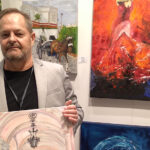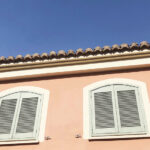Did you know that a rhino is responsible for the creation of the Portuguese calçada? No, you did not misread that – nor is it a joke.
By Sílvia Carvalho d’Almeida
History says that the King of Portugal, D. Manuel I, decided to do a march in the streets of Lisbon for his birthday on 21 January, where a rhino from India would be presented, for the first time, to the crowd. As it was winter, it would probably rain, and the king didn’t want the richly ornamented royal family and himself to get dirty with mud, so he decided to pave the floor, a decision which explains the origin of the Portuguese calçada. This operation involved a great deal of money, because the granite stones came from Porto.
This was around 1500, and the rhino, whose name was Ganga (after the sacred Indian river) was offered to D. Manuel I as a gift from Modofar, the King of Cambaia in India. D. Manuel wanted to build an embassy there and sent an ambassador with presents to the king to try to persuade him. Modofar didn’t agree with the request, but in return offered him a rhino.
It was the first time such an animal had set foot on European soil since the third century, and its presence caused immense curiosity. Ganga was installed at Ribeira’s Palace along with an elephant. D. Manuel organised combat between the two animals, which was attended by him and the queen, plus other important guests. The elephant ran as soon as he saw the rhino.
To guarantee the support of the Pope to Portuguese expansion, D. Manuel sent him many gifts: one of these gifts was Ganga. Tragically, the ship sank and Ganga drowned (rhinos can swim but he was tied up). His body was later found, impaled and sent to the Holy Priest.
Portuguese calçada is famous worldwide. Tourists come to Portugal to see this beautiful art form. These traditional pavements are also popular in other countries, particularly France, perhaps because so many Portuguese go there as emigrants.
The Brazilian who builds Portuguese calçada
Marcelo Santana left Brazil at 18 to try his luck in Portugal. Back there, he worked in a pharmacy, but things were not going well and he decided to emigrate. When he arrived in Portugal, an opportunity arose for him to learn how to build Portuguese calçada, in an internship that lasted for three months.
He learned from a friend, but at the time there were courses from the Employment Centre for those who were willing to learn. “Back then there was training available,” he explains. “But young people do not want to do this anymore, and the opportunities for learning this craft are now fewer than before.”
For Marcelo, this is an advantage, because he always has work, especially now that he opened his own business.
His wife works with him, and they have two little children, a girl who is five and a three-year-old boy. A typical day starts with taking kids to kindergarten before 9 o’clock, since this is the time they need to start working to complete six hours per day of labour. They leave at 4 pm to get the children from school at 5 pm. The craftsman says they are “in a hurry” all day long, to be able to care and spend time with their babies at the end of the day.
The work is hard, and particularly tough on the back and knees, but it is what Marcelo loves to do. He has no regrets about giving up his career as a pharmacy technician and does not believe people look down on him because of what he does. On the contrary, he gets a lot of compliments for his work, especially from passing tourists. For Marcelo, his work is a form of art, and he would like his children to learn how to do it, and to study arts, even though they “will be free to do whatever they want in life”.
+351 963 940 228 (Marcelo)
Facebook: Marcelo Santana
















